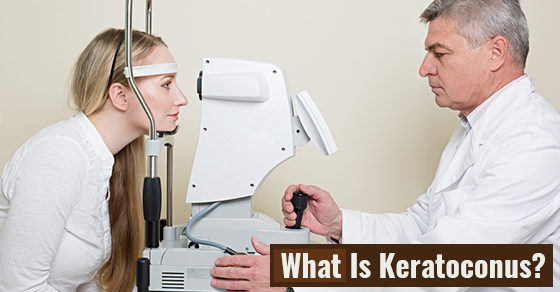What Is Keratoconus?
Monday, June 19th, 2017, 10:00 amThe cornea is the clear, dome-shaped window that lies at the front of the eye, focusing light. Because the cornea is dome-shaped, it allows light to focus as it enters the eye. When the cornea changes shape, the rays of light will be out of focus and vision will be distorted and blurry. This is called keratoconus, and it occurs when the cornea bulges outwards like a cone instead of retaining its normal dome shape.

What are the causes of keratoconus?
Unfortunately, doctors have yet to discover why people have keratoconus. However, they have discovered that it is usually genetic and generally starts in the late teens to early 20s. The symptoms get worse slowly for a period of 10-20 years. In order to diagnose keratoconus, your ophthalmologist will perform a routine eye exam and measure your cornea. A map of your cornea may also be created, using a special computer. This allows the doctor to see a detailed image of the corneal surface.
What are the symptoms?
Keratoconus can affect one or both eyes, and symptoms may not be the same for each eye. In the early stages of keratoconus, you may notice a mild blurring of your vision and increased sensitivity to light. Furthermore, your eyes can be red and swollen and straight lines appear bent or wavy when you look at them. The later stages of keratoconus are marked by astigmatism or nearsightedness, extremely distorted vision and the inability to wear contact lenses because they do not fit properly over the corneal surface. In severe cases, the cornea will scar.
What treatments are available?
The stage of keratoconus and the symptoms your are experience will determine the treatment necessary to help correct this issue. The milder symptoms can be treated with glasses or special hard contact lenses to focus your vision. Your eye doctor may also recommended intacs, which are small curved devices that are surgically placed in the cornea to improve vision. Additionally, there is a procedure called collagen cross-linking, where your ophthalmologist uses a UV light coupled with eye drops to flatten or stiffen the cornea to keep it from bulging out further. Finally, for severe cases of keratoconus a corneal transplant can be done through which your diseased cornea is replaced by healthy corneal tissue from a donor.
If you have recently been diagnosed with keratoconus or have any of the symptoms, the worst thing you can do is rub your eyes. When you rub your eyes, you are further damaging the corneal tissue, which will not only make your keratoconus worse but make your eyes even itchier and red.
Category: Keratoconus
